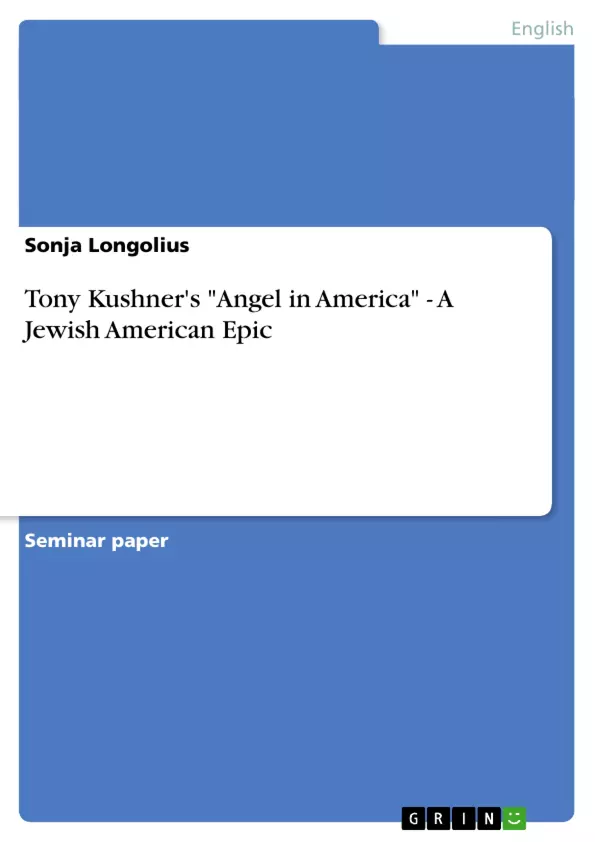Much has been written about the homosexual and political playwright Tony Kushner. Interestingly, not so much has been said about his Jewish background and its impact on his dramatic work. Especially, his most acknowledged play "Angels in America – A Gay Fantasia on National Themes" which is mainly set in New York City "this strange place, in the melting pot where nothing melted" as Rabbi Isidor Chemelwitz observes in the first scene of "Millennium Approaches", is highly concerned with Judaism in general and American Jewry in particular. Naturally, different readings of Kushner's two-part play are possible. Nevertheless, it is crucial to reveal and analyze the importance of the Jewish tone and setting in "Angels in America" to fully understand Kushner's complex work.
Kushner picks out the topic of religion and traditional heritage in our secular, modern world as one of his central themes. As Hilary de Vries wrote in her Chicago Tribune critique, "Kushner credits much of his interest in religion to his family background as part of the little known but thriving Jewish community in [Lake Charles] Louisiana." When Kushner moved to New York City in 1974, the Jewish population of the city was over one million making it the largest Jewish community in the world. Even though "Kushner struggles with an ambivalence toward Judaism due to homophobic traditions within his faith," as James Fisher stated, he nevertheless strongly connects to his own Eastern European roots. Kushner's ambivalence is that of American Jewry in general, being torn between the modern, secular society and historical ties to ethnic and religious identity. This dilemma is put forward through the play's fine-nuanced Jewish characters. Furthermore, the play circles around general religious allegories, which origins can be traced back to writings of Judaism, such as the Old Testament and the Kabbalah, as well as to Christian traditions.
Inhaltsverzeichnis (Table of Contents)
- Introduction
- Tony Kushner's diverse Jewish Characters
- The Old Meets the New World: The Rabbi, Sarah and Louis Ironson
- The Real Meets the Fictitious World: Roy M. Cohn (1927-1986) and Ethel Greenglass Rosenberg (1915-1953)
- Tony Kushner's Angels
Zielsetzung und Themenschwerpunkte (Objectives and Key Themes)
This essay aims to explore the Jewish background of playwright Tony Kushner and its impact on his dramatic work, focusing particularly on his play "Angels in America - A Gay Fantasia on National Themes." It examines the significance of Jewish themes and settings in understanding the play's complexities.
- The influence of Jewish tradition and heritage on the play's themes and characters.
- The portrayal of diverse Jewish experiences in America, including secularism, tradition, and generational differences.
- The impact of the AIDS pandemic on the gay community and the play's exploration of religious and secular perspectives.
- The exploration of issues of race, class, gender, sexuality, and politics in America during the conservative Reagan Era.
Zusammenfassung der Kapitel (Chapter Summaries)
The introduction establishes the importance of analyzing the Jewish context of "Angels in America" to fully grasp the play's complexities. The play's setting in the mid-1980s and its diverse characters, including Prior Walter, Joe Pitt, Harper Pitt, Hannah Pitt, Belize, Roy Cohn, and Louis Ironson, are introduced. The essay highlights the play's exploration of religion and traditional heritage within a modern, secular world, focusing on the AIDS pandemic and its impact on the gay movement.
The second chapter examines Kushner's diverse Jewish characters, including Louis Ironson, Sarah Ironson, Rabbi Isidor Chemelwitz, Roy M. Cohn, and Ethel Rosenberg. The essay emphasizes how Kushner challenges stereotypical Jewish representations by portraying these characters as complex individuals, defying expectations and revealing internal contradictions.
The chapter "The Old Meets the New World: The Rabbi, Sarah and Louis Ironson" delves into the play's first scene, a monologue by Rabbi Isidor Chemelwitz during Sarah Ironson's funeral. This scene sets the stage for a contrast between the traditional lives of former Jewish immigrants from Eastern Europe and the secular world of their American descendants. The essay discusses the generational divide, the impact of immigration on American Jewish identity, and the ongoing struggle to balance religious and secular aspects of life.
Schlüsselwörter (Keywords)
This essay explores key themes and concepts such as Jewish identity, American Jewry, generational conflict, secularism and tradition, the AIDS pandemic, the gay movement, political and social issues in 1980s America, and the representation of diverse Jewish characters in literature and theatre.
- Quote paper
- Sonja Longolius (Author), 2004, Tony Kushner's "Angel in America" - A Jewish American Epic, Munich, GRIN Verlag, https://www.grin.com/document/41723



